Nazca Overview
- Nazca offers like destination a unique place in the world, full of mystery and mysticism, wonderful lines of immense figures and lines, of spectacular perfection, works of a very old Peruvian civilization, the lines of Nazca.
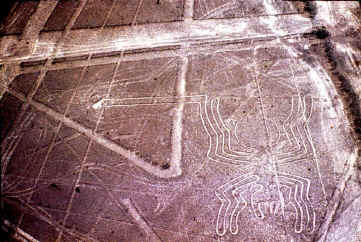
Just two hours from Ica, 50 square km of desert floor were covered centuries ago by vast drawings, figures of mammals, insects and deities. The Nazca Lines, discovered in 1927, are the most extraordinary legacy left by a culture that flourished in 300 BC. The lines are a series of complex designs, some up to 300 meters long which can only be seen in their true dimension from the sky, from an altitude of at least 1,500 feet. The Nazca culture is not believed to have been capable of manned flight. But the question remains as to how they crafted the drawings, what technology they used and what purpose the lines served.

The town of Nazca was founded in 1591 by the Spaniards, on the valley of Nazca, close to towns inhabited by old civilizations that had been dominated by the Inca. The ancestral name was Nanasca.
Nazca Lines
Declared "Archaeological World Heritage Site" by UNESCO (1994). Located in the arid Peruvian coastal plain, some 400 km south of Lima, the geoglyphs of Nazca and the pampas of Jumana cover about 450 sq. km. These lines, which were scratched on the surface of the ground between 500 B.C. and A.D. 500, are among archaeology's greatest enigmas because of their quantity, nature, size and continuity. The geoglyphs depict living creatures, stylized plants and imaginary beings, as well as geometric figures several kilometers long. They are believed to have had ritual astronomical functions. In order to appreciate the lines in all its magnitude, it is only possible from an airplane in flight.
Archaeological places to north of Nazca City
Aqueducts of Nazca (Puquios) - Cantayoc
Archaeological remains of the Nazca culture, it shows the high development reached in hydraulic engineering, complex of underground aqueducts and reservoirs.
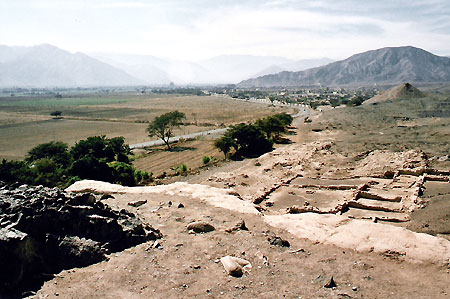
"Paredones" (walls)
Archaeological Inca center, located at 2 km (1.24 miles) East of Nazca. Constructions of plazas, deposits, fortresses, ceremonial center.
Archaeological places to south of Nazca City
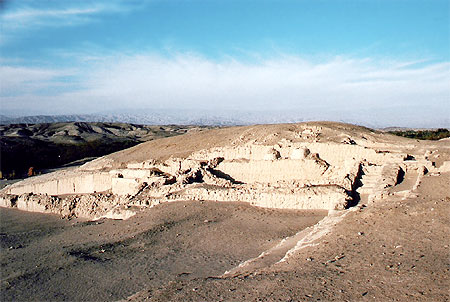
Cahuachi
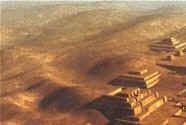 Cahuachi was a ceremonial center, a sacred destination of Nazca pilgrims between 100 and 500 AD. The ceremonies in the place included the construction of temples using thousands of conical or wedge adobe bricks. Each participating community demonstrated their true belonging to their religious community by singing, dancing and banqueting, thus explaining why in Cahuachi there is little garbage, while offerings abound (pan flutes and musical drums, sacrificed llamas and guinea pigs, fine textiles, human burials and pottery representing deities). Main cultural-urban center, built with great urban sense. The ancient Nazca people built their pyramidal temples by terracing the fossil sand dunes. In the lowers parts, smaller architectural mounds, streets and squares give the site a general city aspect. Attached to this town were also discovered (1980) a group of lines traced on the floor in form of trapezes and serpentines that embrace 1 square km. It is located at 27 km (16.77 miles) to south of Nazca.
Cahuachi was a ceremonial center, a sacred destination of Nazca pilgrims between 100 and 500 AD. The ceremonies in the place included the construction of temples using thousands of conical or wedge adobe bricks. Each participating community demonstrated their true belonging to their religious community by singing, dancing and banqueting, thus explaining why in Cahuachi there is little garbage, while offerings abound (pan flutes and musical drums, sacrificed llamas and guinea pigs, fine textiles, human burials and pottery representing deities). Main cultural-urban center, built with great urban sense. The ancient Nazca people built their pyramidal temples by terracing the fossil sand dunes. In the lowers parts, smaller architectural mounds, streets and squares give the site a general city aspect. Attached to this town were also discovered (1980) a group of lines traced on the floor in form of trapezes and serpentines that embrace 1 square km. It is located at 27 km (16.77 miles) to south of Nazca.
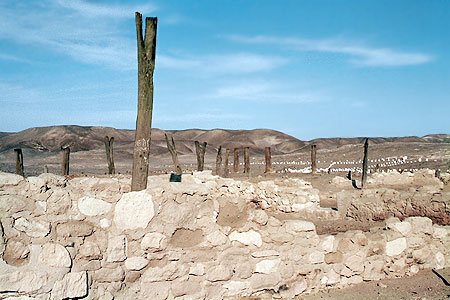
Estaqueria
Archaeological complex of the Nazca culture, solar observatory, on platforms made of adobes and columns of "huarangos" trunks (variety of tree). This archaeological complex is near to Cahuachi.
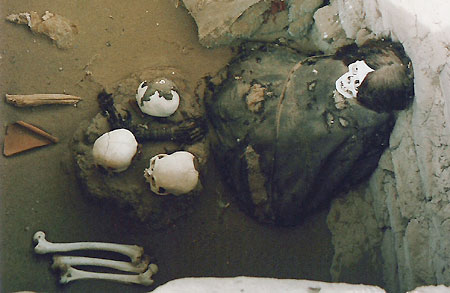
Chauchilla
Pre-Inca cemetery, in which the profanation of tombs by the huaqueros, have left open some tombs in which you can appreciate the old inhabitants' remains. It is located at 28 km (17.4 miles) to the south of Nazca.
Sacaco
Located at 100 km (62 miles) to the S of Nazca, it is a rich location of fossil remains, especially of whales and primitive sharks of the Tertiary Era. Small paleontological museum. To arrive to this area, you should take the Pan-American South Highway until kilometer 539 and take a detour of 1.5 km to the museum site.

Planetarium Maria Reich
Venturing into boundaries of the world archae-astronomy, the Nazca Lines show present Maria Reiche's theory, and the connection she found between the Nazca Lines and some astronomical events. She theorized the lines were oriented towards the places on the horizon where different celestial objects appeared and disappeared. After the show, weather permitting in a backyard exploration of the night sky, have a naked-eye view of the constellations and bright stars of the season along with telescope, observation of the moon, planets, and other celestial marvels. Located in Jr. Bolognesi N? 300 - Hotel Nazca Lines.
Punta San Juan de Marcona Reserved Area
Located in the coast area, to the west of the Nazca city, it is an extraordinary marine ecosystem of great biodiversity; it has a little extension of 54 hectares and has the biggest population of sea lions (seals) of the Peru concentrates. The peninsula is characterized by its abrupt cliffs 30 meters high that hinder the access, from the high part, to the eighteen beaches that are formed at level of the reef. Besides the sea lions, in this Reserved Area inhabits the biggest colony of penguins of Humboldt (Spheniscus humboldtii) (it is considered that concentrates more than 50% of the total population of this species on the Peru), as well as zarcillos (Larosterna inca) and the three main species of dung birds (guaneras). While the sea lions are located in the beaches and salient rocky, the penguins look for the protection of the cavities that they are formed in the walls of the cliffs and the birds rest and they nest in the sharp hillsides and in the plateau that extends in their higher area. (UNMSM)